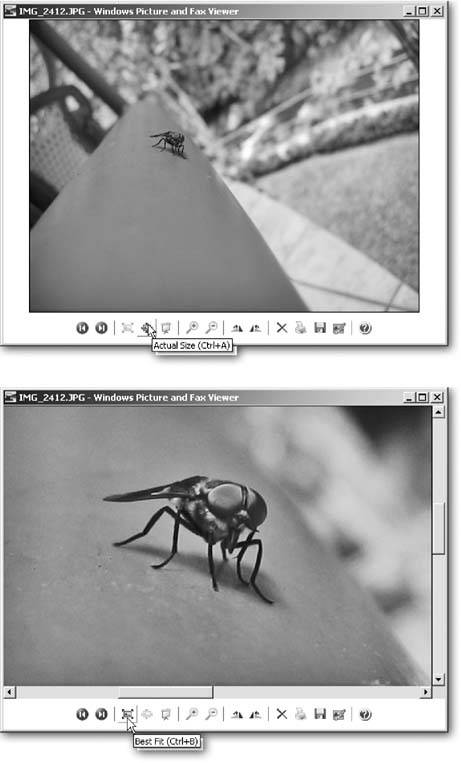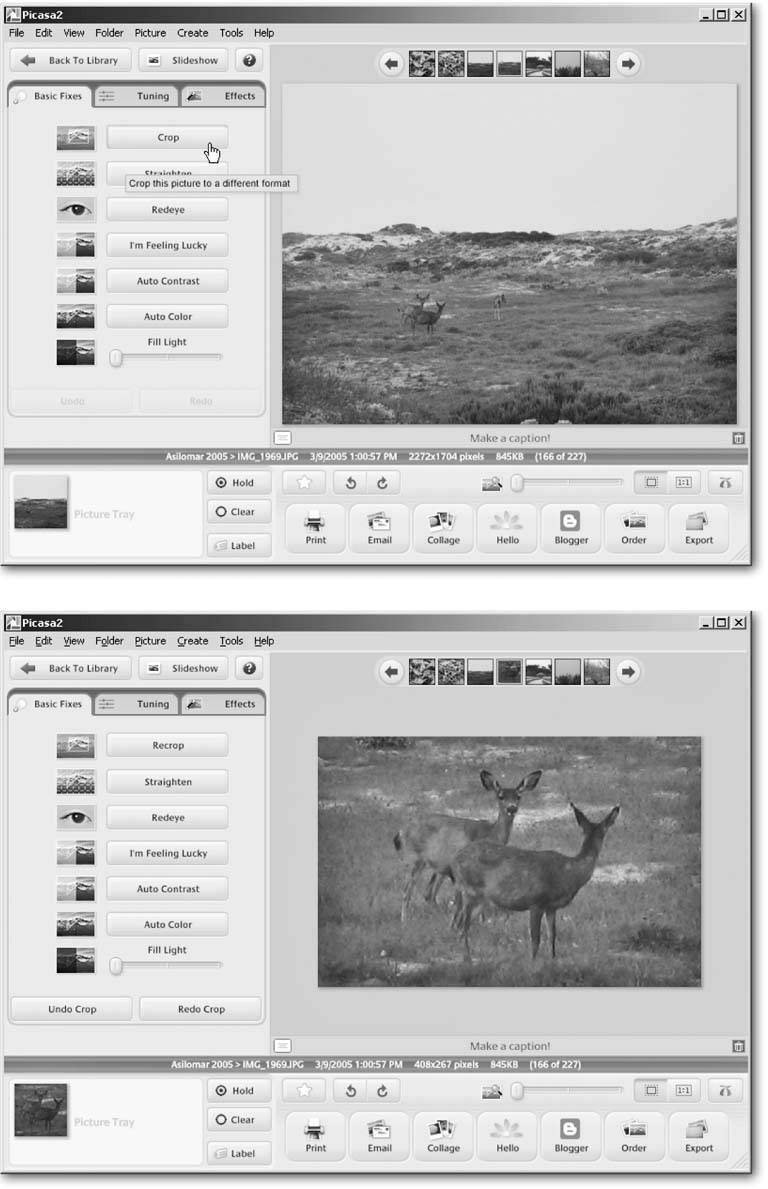5.5. Sharing Photos with Friends To go retro when sharing photos, just print them out (Section 4.7) and pass them around in person. But digital photos cry out for a more immediate approach. Here's how to share them through email or a file-sharing site. 5.5.1. Sending Photos Through Email Sending photos through email is like dropping a block of ice into a drinking glass: the photos' immense size keeps them from fitting comfortably into an email message, which works best with text and small attachments. You may not have noticed your digital photos' mammoth size because Windows XP hides it from you. To keep you from examining nose pores instead of portraits, Windows XP politely shrinks opened photos to make them suitable for onscreen viewing. For instance, Figure 5-7, top, shows a digital photo opened with Windows Picture and Fax Viewernote the tiny fly on the railing. When viewed at actual size (see Figure 5-7, bottom), that tiny fly's really a monster. Large digital photos (usually around 1 or 2 MB apiece) make for great prints but lousy email attachments. Even if your ISP lets you send the photo (and many won't, because of size restrictions), the photo would probably bounce back when it overflowed your friend's mail storage limit (usually 5 or 10 MB). The only answer is to shrink the photo, leaving you two options: -
Resize . Windows shrinks your photos automatically if you email them. Right-click a selected photo or photos and choose Send To  Mail Recipient. When you take up Windows offer to "Make all my pictures smaller," Windows shrinks them to 640 x 480 pixelsa comfortable viewing size for most displays. (If the recipient owns an extra large monitor, click "Show more options" and choose either 800 x 600 pixels or 1024 x 768 pixels.) Mail Recipient. When you take up Windows offer to "Make all my pictures smaller," Windows shrinks them to 640 x 480 pixelsa comfortable viewing size for most displays. (If the recipient owns an extra large monitor, click "Show more options" and choose either 800 x 600 pixels or 1024 x 768 pixels.) -
Crop . Resizing a photo doesn't work well for shots where you need to preserve details. Those three cute deer grazing in the field, for instance, become three small brown dots in a sea of green. Cropping lets you trim away most of the field, yet save the deer at actual size. Windows XP doesn't offer any cropping tools, but Picasa crops very easily, as shown in Figure 5-8. Figure 5-7. Top: Windows XP automatically shrinks digital photos to fit into the Windows Picture and Fax Viewer. To see your photo's true size, click the Actual Size buttonthe fourth button from the bottom left.
Bottom: When Windows displays the actual- sized photo, most of it hangs beyond the window's borders, leaving just a tiny portion visible. (To shrink the entire photo back into the window, click the Best Fit buttonthe third button over from the bottom left.) Although Windows XP lets you see portions of photos at their actual size, it doesn't provide a way to save that portion separately from the photo. For that, you need photo-editing software with a cropping feature (Figure 5-8). 
When emailing photos, never dump a huge batch into email and mass-mail. No matter how great a time you had in Belize, few friends want to wade through a wad of vacation photos. Instead, choose a favorite or two to sum up the experience, and send those. Snap-happy people occasionally end up on "twit filters" (Section 12.7.2), especially when they send photos to friends at work. For better etiquette, upload your photos to a photo-sharing site and send your friends the link to view your masterpieces on their own time. Figure 5-8. Top: Like Windows, Picasa can resize a photo for sending through email. But in this case, resizing the entire photo shrinks the deer into little specks, which makes for a pretty boring photo.
Bottom: Unlike Windows, Picasa offers a crop tool, letting you place a resizable rectangle around the most important portion of your photothen save just that portion. By cropping out all of the photo except for the deer, for instance, this photo becomes small enough to send through email, yet still shows the portion that matters: those cute deer and their big ears. 
5.5.2. Posting Photos on a Sharing Site Instead of emailing digital photos to a few select friends, some folks share their pet, party, and parade photos with the world. Photo-sharing sites give you an easy-to-use Web page to display your photos, whether sent from a computer or a camera phone. Send friends the link, and they can drop by to see your photos in a slide show, complete with your captions or annotations. Here are some of the most popular. 5.5.2.1. Flickr Six hundred thousand people worldwide dump their photos at Flickr (www.flickr.com), but the site's much more than an online picture frame. Sure, Flickr offers the usual photo-sharing tools: send friends a link to your Flickr "photostream" for browsing or viewing in a slide show. Flickr even lets you annotate parts of photos, showing friends exactly where in the river that big lunker took the lure yesterday . But Flickr takes sharing to the extreme, making it easy for not only you, but also the entire world, to retrieve your photos. It shares photos through the use of tags simple, descriptive words like "Large Green Beetle Costa Rica" that you append to your uploaded photos. Your tagged photos become part of the collective photographic consciousness, letting you and Costa Rican entomologists and bug fetishists worldwide locate your photos quickly and easily. Should you choose, your photos can remain hidden to all but selected friends. But most uploaders enjoy Flickr's groupthink spirit, granting strangers access to almost everything. Visitors can view where you caught your bass, and leave a comment pointing out where they got lucky. Of course, visitors could just as easily leave a note saying, "You stink," revealing a potential problem: Flickr's open philosophy could easily sink into a pit of spam and crude vandalism. But so far, it's grown quickly into an easily searchable, eight-million-photo library that's much more than the sum of its parts. Free account holders may upload up to 20 MB of photos ( roughly 20 to 100 photos, depending on their size) every month. Professional account members ($24.95 a year) may upload 2 GB (10 times as many photos) each month, send larger sized photos, and enjoy other privileges. Flickr's partnership with Qoop (www.qoop.com) allows members to print bound books of their photos starting at $8.95 or print a poster for $9.99. Calendars, postcards, coffee mugs, and single prints are also available. 5.5.2.2. Kodak EasyShare Gallery Whereas Flickr lets anybody with a camera walk in the door, Kodak's EasyShare Gallery (www.kodakgallery.com) prefers privacy. Drop-by visitors must create an account before viewing any photos. The online site brims with more than 20 million members and one billion photos, partly from Kodak's 2001 purchase of Ofoto, a popular online photo-sharing site. Renamed to Kodak EasyShare Gallery in mid-2005, the site also collects visitors straight from Windows XP: your My Pictures folder shuttles you to Kodak's site, among others, when you click the "Order Photos Online" link (Section 5.3). Like most online photo-sharing sites, the EasyShare Gallery lets you store, view, and share photos with specified friends and family. But it's no secret that Kodak caters primarily to people who want to print digital photos on Kodak paper. (Or on Kodak's line of calendars, cards, mugs, mouse pads, aprons, frames , and other swag.) In addition to printing photos, the site offers simple online editing tools for removing red-eye, cropping and rotating, and adjusting color . Toss on a few borders and effects, send your work to Kodak, and wait a few days for your prints to arrive in the mail. 5.5.2.3. Fotolog Fotolog (www.fotolog.com) bills itself as a photo bloga sort of online diary based on images, rather than words. To reduce the deluge of photos, members may upload only a single photo each day. As the Web site puts it, "Fotolog is more the kind of place where you'd put up a different photo of your children each day or each week so your friends and family could check in to see how they're growing up." Even with a limit of one photo per day, the site boasts more than a million "Fotologgers," who've swollen the database to more than 44 million photos. The site doesn't offer searches, so you need the account holder's name to ferret out their photos from the jumble . Fotolog offers neither printing services nor professional accounts. So, how does it pay the bills? Three hobbyists run Fotolog, and request donations of $5 a month to help pay their bills. |
 Mail Recipient. When you take up Windows offer to "Make all my pictures smaller," Windows shrinks them to 640 x 480 pixelsa comfortable viewing size for most displays. (If the recipient owns an extra large monitor, click "Show more options" and choose either 800 x 600 pixels or 1024 x 768 pixels.)
Mail Recipient. When you take up Windows offer to "Make all my pictures smaller," Windows shrinks them to 640 x 480 pixelsa comfortable viewing size for most displays. (If the recipient owns an extra large monitor, click "Show more options" and choose either 800 x 600 pixels or 1024 x 768 pixels.) 
